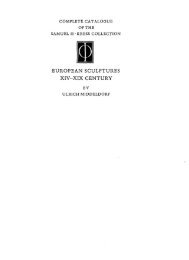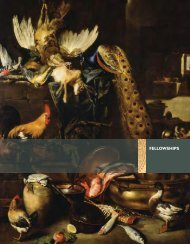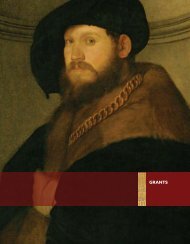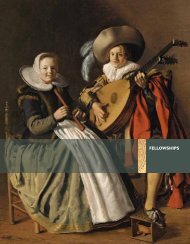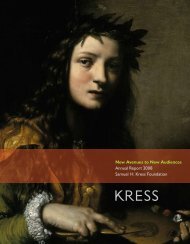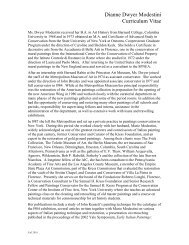The Campus Art Museum - Samuel H. Kress Foundation
The Campus Art Museum - Samuel H. Kress Foundation
The Campus Art Museum - Samuel H. Kress Foundation
Create successful ePaper yourself
Turn your PDF publications into a flip-book with our unique Google optimized e-Paper software.
professors about using the museum and sometimes put together a specialized tour 5<br />
for the class as an education curator relates:<br />
If there are student docents majoring in areas, especially outside of the arts,<br />
and they come up with their own ideas for a potential tour or way to do a<br />
class then we let them take a lead on that with professors. We’ve had… a tour<br />
for a French class and… a fantastic astronomy show…. We’ve had students do<br />
feminist philosophy and neuroscience.<br />
Student docents sometimes take part in the museum’s talk series or gallery<br />
presentations, perhaps discussing a work of art in the collection that they have<br />
researched. Friends of the student, who may not be that familiar with the museum,<br />
are likely to attend the talk as noted by a music professor. “Docent talks are<br />
wonderful, especially in that it helps bringing in students or colleagues that don’t<br />
go to the museum.” <strong>Museum</strong>s also create student advisory councils or boards<br />
whose role, in part, is to link the museum with professors and classes.<br />
Committees, Meetings, and Course Development Grants<br />
“It becomes a matter<br />
of building personal<br />
connections so I try to<br />
show up at university<br />
events .... I just talk<br />
to people who seem<br />
interested and I try to<br />
find venues that will<br />
allow me to do that.”<br />
Academic Coordinator<br />
Some art museums strategically include faculty on museum committees, thus<br />
informing more people about the work and challenges of the museum while<br />
spreading the support base. An area studies director found his involvement<br />
rewarding: “We’ve worked a lot with the museum in a personal way and an<br />
organizational way. I’m on the acquisitions committee, so for me that’s really nice<br />
because I get to see lovely objects once or twice a month.” Through a series of<br />
luncheons, the Smart brings people from across the curriculum together to discuss<br />
ways in which their research, scholarship, and expertise can be brought to bear on<br />
special exhibitions.<br />
Some campus art museums are also able to offer modest grants for faculty<br />
“to work on a research initiative or to teach using the collection more effectively.”<br />
Professors who receive such grants often spend the summer working with objects in the<br />
museum’s collection that are of interest to them for teaching or research. For example,<br />
a literature professor received a grant to explore his interest in relations among poets,<br />
their subject matter, and art from the same geographic locations and time periods.<br />
Personal Outreach and Connections<br />
Personal outreach by museum staff seems to be a particularly effective strategy<br />
for getting faculty who may be unfamiliar with the art world to consider whether<br />
they too could use the museum in their courses. This outreach tends to happen in<br />
everyday conversations as in this connection between a biology professor and a<br />
museum director:<br />
5. Although tour appears to be the word most frequently used for curator, educator, or docent-led museum programs,<br />
some museums take issue with the connotations of the word and have created other descriptors such as curriculumstructured<br />
gallery program, used at the IUAM.<br />
Attracting Faculty to the <strong>Campus</strong> <strong>Art</strong> <strong>Museum</strong><br />
9



